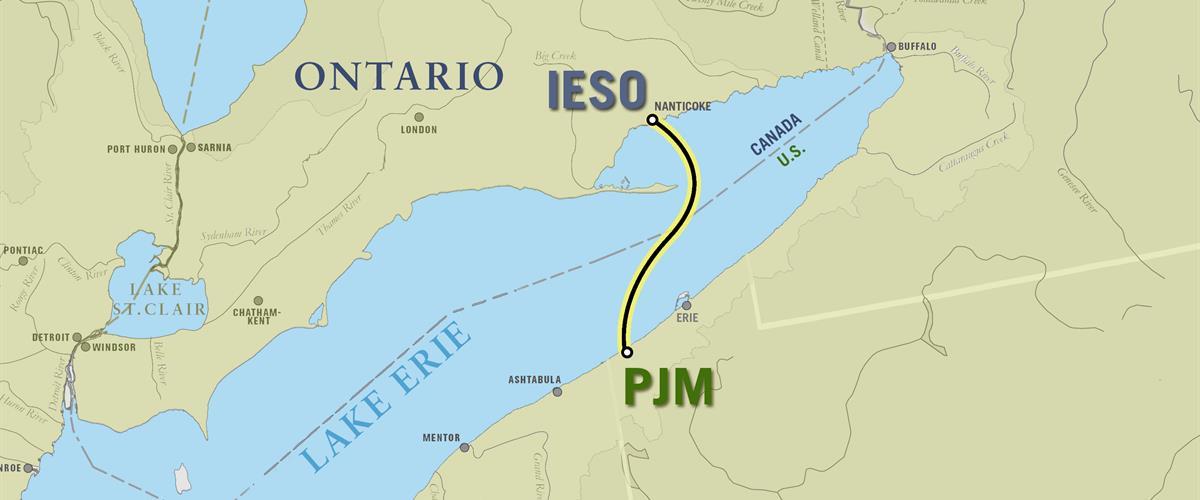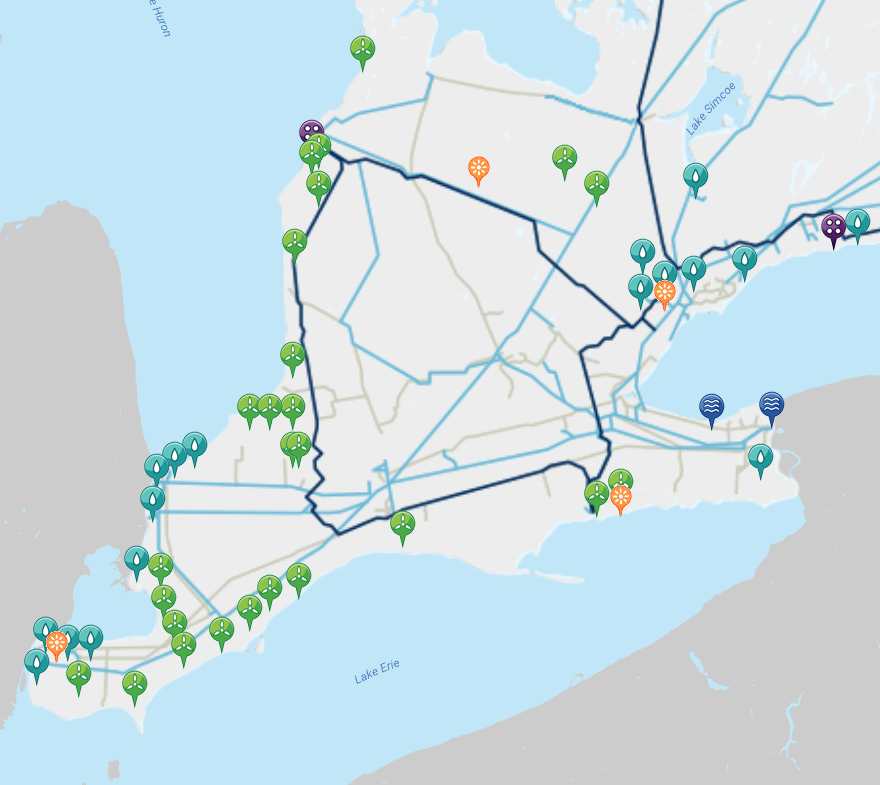
Image source: ITC/Fortis
Canada trades electricity across the border with the United States. This trade has faced capacity limitations due to a limited number of high-voltage transmission lines. Slowly and steadily, several projects are improving our cross-border links. Perhaps the most important project is the ITC Lake Erie Connector Project, which will carry 1,000 Megawatt (MW) on a bi-directional High-Voltage Direct Current (HVDC) underwater transmission line across Lake Erie, as shown in the map above. The new transmission line was approved by Canada's National Energy Board in 2017. When this 117-kilometer transmission line between Nanticoke, Ontario and Erie, Pennsylvania is completed in 2021, it will connect Ontario's power market with the thirteen US states in the PJM interconnection. The new line will give Ontario's Independent Electricity Systems Operator (IESO) the opportunity to balance its load more effectively, which in recent years has struggled with accommodating the surge of renewable electricity especially in Southern Ontario, where windfarms cluster around the lake shores (see map below).

Fortis, based in St. John's in Newfoundland, acquired the Michigan-based ITC Holding Corporation in 2016 for USD 11.3 billion, the largest deal in the company's history. As the United States is transitioning away from coal to natural gas and renewables, the transmission company ITC with over 25,000 kilometers of transmission lines is a key player. This strategic move is an interesting portfolio expansion for Fortis, with the US side of its business now growing larger than its Canadian side. ITC has numerous projects on the go, and the Lake Erie project is one of the more important pieces in the puzzle.
Fortis started out in 1885 as St. John's Electric Light Company, and in 1987 Fortis became a holding company with the goal to become a diversified North American utility. Today, Fortis operates in five Canadian provinces as well as the United States and three Caribbean countries. Barry Perry, the Chief Executive of Fortis since 2014, has strong roots in Newfoundland and in the utility industry. His vision to grow Fortis into a more significant role in North America comes at an opportune moment. The electricity industry is at the verge of a new era that will be characterized by a transition to renewables, more complex transmission and distribution systems, and emergence of the "smart grid." ITC is a key player in this transition.
There are more cross-border connections on the horizon. The U.S. State Department approved two more transmission line projects: the US$1.2 billion New England Clean Power Link between Quebec and Vermont. A large part of the 240 kilometer transmission line will run underwater through Lake Champlain. This project will carry up to 1,000 MW of power to the New England market. The link will enable Massachusetts to achieve its greenhouse gas reduction targets.
Also approved was the Great Northern Transmission Line between Manitoba and Minnesota. When completed in 2020, the 385 kilometer line will carry up to 750 MW of power. The transmission line will enable Manitoba to export hydro power from its current and new dams. The 695 MW Keeyask dam will be completed in 2019, unfortunately with cost overruns that will bring the project to $8.7 billion. Also under construction is the Bipole III transmission line that will deliver electricity to southern Manitoba and on to the United States. The cross-border link will enable Manitoba Hydro to balance more than 500 MW of win power in Minnesota and neighbouring North Dakota.
The Champlain Hudson Power Express would carry 1,000 MW of hydropower from Quebec to New York City. The Canadian section is is short 50km to Lake Chaplain, run underwater 163km through the lake, and eventually run 108km through the Hudson Rive, and again 44km through the Hudson and Harlem Rivers.
The Northern Pass will also carry power from Quebec on a 308km line from the border to New Hampshire. This project will use HVDC transmission. The project is currently awaiting approval.
The combination of these projects highlights the importance that Canadian electricity plays in the United States. Clean hydropower can make a significant impact and help wean our southern neighbour off coal power, where in 2016 still 30.4% of electricity was produced in coal plants. Use of coal is declining rapidly in the United States. Whereas in 2007 nearly 2,016 Terawatthours (TWh) of electricity was produced from coal, in 2016 this had dropped by almost 40% to 1,240 TWh. So how much can a new 1,000 MW link contribute? If such a link is used year-round at full capacity, it can carry 8.66 TWh of power, or just 0.7% of the total production from coal in 2016. It would take perhaps 150 such transmission lines to supply clean electricity from Canada to fill the gap, and a corresponding amount of generation. The rapid decline of coal is the result of replacement with cheaper and cleaner natural gas, while wind and solar still plays a relatively small role. However, as the share of renewables grows, hydropower from Canada can provide an important stabilizing element in our North American western and eastern power grids.
![[Sauder School of Business]](logo-ubc-sauder-2016.png)
![[The University of British Columbia]](logo-ubc-2016.png)